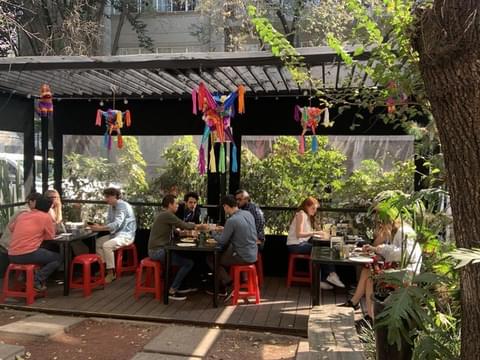Exploring Mexico: Culinary Shifts, Cultural Tensions & The Future of Food.
A semiotician and a food anthropologist walk into a bar…
Except it’s not a bar. It’s a conference room in sunny, beautiful Mexico City in December 2024. Our very own Tanita de Ruijt and Maria Palla Valiente made the 12-hour flight from merry London to vibrant Mexico DF to deliver an innovation workshop. In the flash trip, they delivered behavioral, culinary, ingredient, and JTBD learnings alongside globally sourced inspiration to a regional team eager to take a stab at the future of their category in the fascinating market that is Mexico.
Beyond an invigorating workshop, they explored the city and identified 3 key shifts:
- Rise of Health-Consciousness: In a culture where indulgence is an everyday staple, they noticed a rise in health-focused food products targeted at younger consumers, with sleek, minimalist packaging that emphasizes clean ingredients, no artificial colors, and lower sugar content. While not necessarily a shocking find for the Western eye, it is a declaration of intentions from brands who are still deeply rooted in hedonistic pleasure but who can anticipate the behavioral shift just beginning to take roots in Mexico.
- Mexican Heritage Refresh: Local artisanal products have not always had the status and commanded the premium price tag that they might have outside their borders – something that seems to be changing as brands embrace their heritage more proudly and express it through modern styles, blending traditional Mexican flavors and cultural elements with a contemporary look to appeal to a local and global audience.
- Transparency: Clearer nutritional labels have become standard, and the introduction of local product origin stories are signaling that consumers (particularly wealthier ones – for now) are seeking more transparency and authenticity in their food choices.
Mexico is the 4th market Tanita and Maria have travelled to together to decode culture and behavior while unearthing inspiration for Huxly’s strategic inspiration and local intel bank that fuels the consultancy expertise we provide to commercial approaches. We will be reporting on the next proverbial ‘bar’ they walk into.
Traditional Mexican products, such as obleas, using bold colors and modern designs to elevate the brand’s image and appeal to younger, lifestyle- and aesthetic-conscious consumers.
Local brands are influenced by global packaging trends but maintain Mexican flavors, like quinoa, amaranth, tamarind, cinnamon, and chili, which resonate with both local pride and health-conscious values.
In the alcohol category, where tequila dominates, a combination of modern design with deep-rooted Mexican heritage helps brands connect with both local and international consumers.
Packaging has become a key tool for differentiation. In a landscape crowded with products, adopting global design cues allows local brands to stand out on shelves and signal to consumers that they are part of a more sophisticated, transparent, and quality-driven movement.
By merging global design trends with Mexican cultural elements, brands can appeal to a modern consumer base while maintaining authenticity.
This blend of tradition and modernity not only reshapes how Mexican food is perceived domestically but also strengthens its global appeal, offering a unique point of difference for international markets.
Leveraging culinary & cultural trends is essential when crafting future positioning and innovation strategies. If you are interested in understanding how Huxly’s culinary innovation & sensory semiotics team can help unlock & translate culturally relevant trends, then reach out today!




































